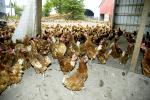COLUMBIA, Mo. – Soybeans were introduced on Missouri farms as a hay crop, not an oilseed crop. That started back in the dry years of the 1930s.
This year, cow-herd owners short on feed are asking about baling soybeans that won’t make a bean crop.
Rob Kallenbach, University of Missouri Extension forage specialist, answers two questions the callers do not ask.
“Before you do anything, call your crop insurance agent,” Kallenbach says. “Determine the crop-indemnity payment before cutting soybeans for hay.”
“Second, read the label.” A big consideration, not relevant in the 1930s, will be pesticides used on the crop.
Many label restrictions prevent soybean use for forages, MU specialists warn. Read the label on everything applied.
Getting back to the original question, Kallenbach says, “Yes, soybeans make good forage.”
Soybean hay has a crude protein of 16-19 percent. The total digestible nutrients (TDN) run in the mid-50s. “That will be better than most hay, except for other legumes such as alfalfa,” Kallenbach says. “The forage is very palatable and makes good feed for beef or dairy cows.”
Growers know that the soybean keeps setting blossoms, trying to make seed. As unpollinated blossoms dry and fall off, new buds emerge from each leaf node.
“What we don’t know is how long soybeans will keep trying this year,” says Bill Wiebold, MU Extension soybean specialist. “Usually we have an August drought only. The soybean can survive that. This year, drought could last 90 days. The bean plant will run out of blossoms at some point.
“After the bean stops trying to make seed, the plant drops its leaves. That provides a very short window. Forage can be made in that time.
“The soybean can go from looking not too bad to dead in a few days. Just a word to the wise.”
Kevin Bradley, MU Extension weed specialist, repeated the warning to read herbicide labels. “If you used glyphosate herbicide only, there is a 15-day waiting period before grazing the soybean.”
However, most herbicides sprayed will not be approved for grazing or harvesting for hay. “It’s just that no company invested in research to determine safe-grazing limits,” Bradley says. “It’s not usually a question that comes up.”
There is a risk of chemical residue showing up in milk or meat on unsafe grazing.
A windshield tour across Missouri indicated there are soybean fields that could make forage, Kallenbach says. “The beans are short, so there won’t be maximum hay yield in many places. The crop is extremely variable.”
“Making soybean hay can be a pain in the neck,” he warns. “The stems and pods cure slowly. Leaf loss may become a problem.”
A crimper on the hay-mowing machine will speed drying.
Rather than making hay, Kallenbach prefers ensiling the forage. The soybean crop can be fermented in a silo or stored in plastic bags. Haylage is easier to make than hay, Kallenbach says.
The high-protein soybean hay can be mixed with other, lower-quality hay in a tub grinder to make a total mixed ration (TMR), Kallenbach says. “In times of scarce forage, everything must be done to reduce waste and extend the use of poorer-quality forages, which are plentiful this year.”
Bean growers might receive an insurance payment for crop loss, then harvest a bonus forage crop. “The price of hay is going up fast,” Kallenbach says.
The crop can also be used as green chop, cutting a wagonload at a time to feed the cattle. There isn’t the danger of high-nitrate poisoning that comes with green-chop corn in this drought year.
State specialists in Columbia hold weekly teleconferences to answer questions from regional extension specialists. They share reports from test plots on the MU research farms of the Missouri Agricultural Experiment Station.
Read more http://extension.missouri.edu/news/DisplayStory.aspx?N=1469





